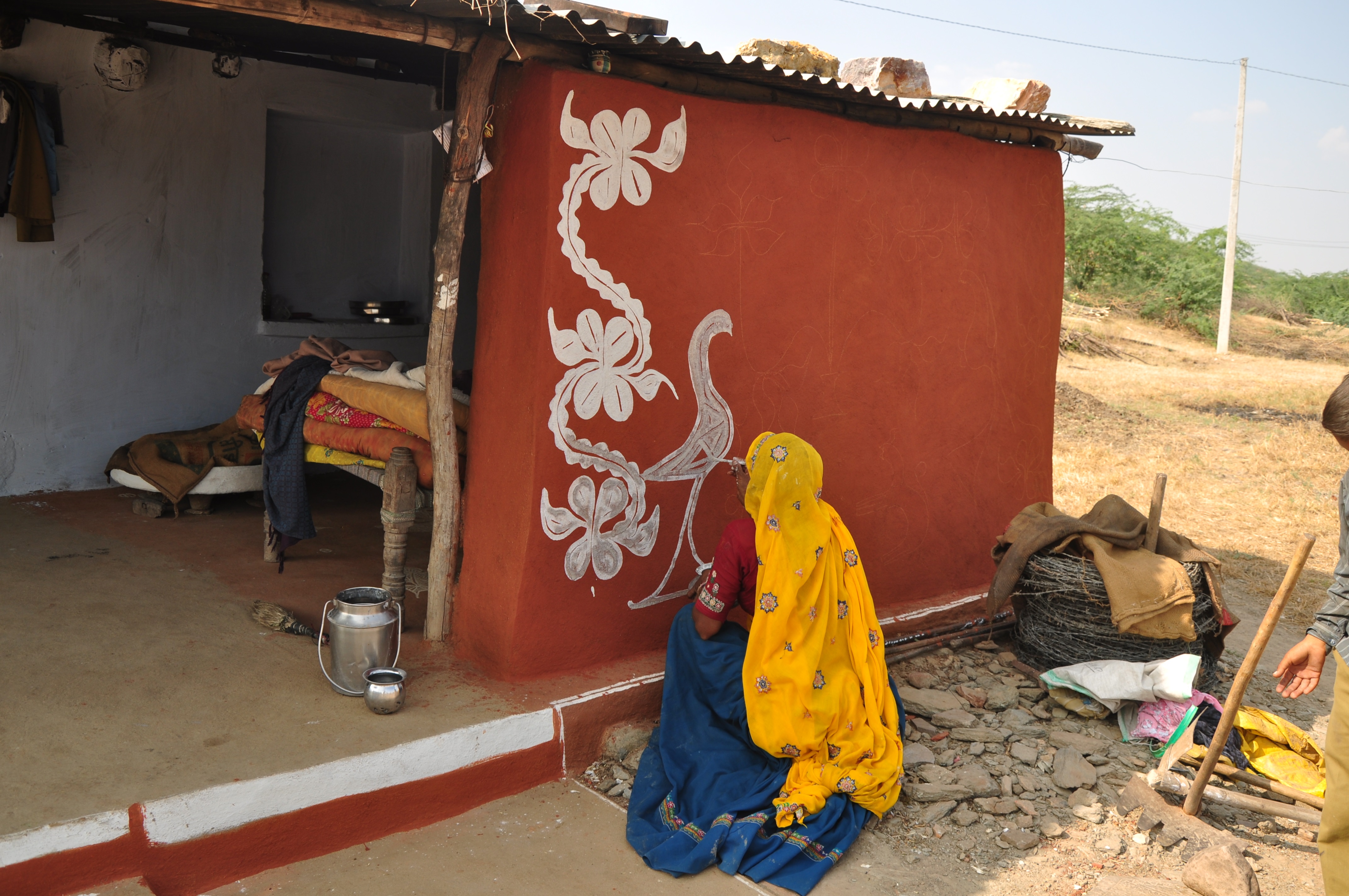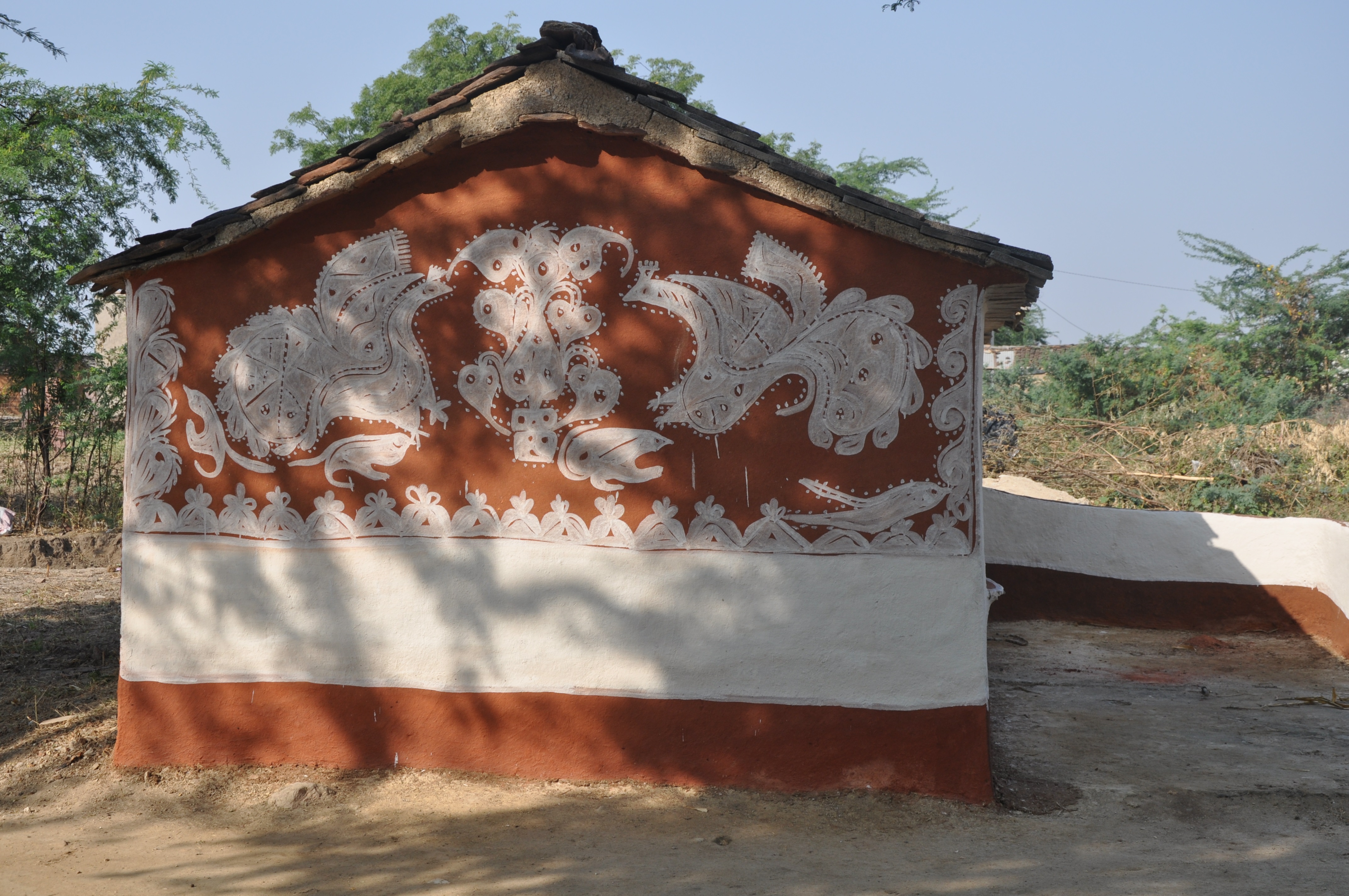Mandana is an ornate visual folk art form of Rajasthan that graces homes on festive and auspicious days, weddings as well as the beginning of winter and summer, planting season and at harvest time. After the expiry of rainy season the rural women folk repair and smear their house with cow-dung or white-wash them with lime and draw the mandana on their floors and walls. Even today, every time the floor is repaired or replastered, a mandana in the form of a small Swastika or few dots is drawn as a bare floor is believed to be inauspicious. ‘It does not matter if a son remains kunwara or unmarried, but an aangan or the courtyard floor should never be left kora or without a mandana’ is a common prevailing sentiment which indicates the importance given to this tradition. A kora aangan is a sign of inauspiciousness. Apart from courtyards, floors of the verandah and other rooms, steps, parapets, water- stands and stoves are also replastered during festive occasions and decorated with mandanas.

The word mandana derives from the word mandan which means ‘to decorate’. In this sense, mandanas are seen as ornaments of the earth. Mandana refers to both – a specific form of drawing and also to the act of drawing.
The ground for making mandana is finished with cow-dung and clay which is usually crimson red, obtained by mixing rati (red earth found locally). This process is refered to as lipai or lipana. Mandanas are drawn by women using kharia, a solution of chalk or kaolin powder obtained by dissolving it in water. The central motif of mandana is highlighted using geru or hirmich (haematite or red oxide).
The lines of the mandana are marked on the floor with the tip of a finger, usually the ring finger. A swab made with a piece of cloth or a tuft of hair is dipped in the liquid pigment and gently pressed between the palm and thumb. This makes the liquid pigment trickle down to the floor through the tip of the ring finger. Women seldom repeat the same design as that would be interpreted as their incompetence.

Though the mandana art is practiced in all the districts of Rajasthan, it is very pre-dominant in the region east of the Aravali hills. The people in the Bharatpur, Kota, Ajmer and Jaipur divisions appear to follow the tradition of mandana even today. Sawai Madhopur in the Bharatpur division has a large population the Meena tribals. The women of the Meena community are traditionally well known for their proficiency in mandana art. Any one traveling through the villages of Sawai Madhopur is richly rewarded by the sight of a variety of patterns decorating even the humblest of homes. As far as mandanas are concerned this region provides a rich field for study and investigation. The villages in between Sawai Madhopur and Tonk viz:- Kakod, Hathi-bata, Uniyara, Aligad, Banjari-ka-dara and many such show exclusivity in mandana art. Similarly villages in Tonk, Bundi and Jhalawar districts are also seen decorated with rich mandanas on festive occasions.
As one enters the village of the Meenas it is inevitable to notice the graphic force of the red and white paintings that cover the surfaces of walls, floors and courtyards amidst the palette of the land dominated by shades of brown. Playing with negative and positive spaces, the art seems to have the power of creating the illusion of colour, form and movement. It is a pure and simple visual feast.
The art of the Meena women is both symbolic and decorative. The continuity of painting mandana has persisted among the Meena women through generations. Mothers teach their daughters to paint and this is the way tradition is passed on. When asked of the reasons of these creations, the answer comes very simple and spontaneous – “chokha lage che” (i.e. it appears good) or “shubha shakun che” (it is auspicious) or “parampara che” (it is a tradition). Their mandanas are not the unique creation of any single individual but a tradition grown in a community.

Topography and the surrounding flora and fauna definitely have an influence on the art and culture of any region. The hilly region of Sawai Madhopur consists of the Ranthambore forest known for its tiger population. It is also home to wide variety of trees, plants, birds and reptiles. Hence it is no surprise that the mandanas of the Meena ladies here depict the flora and fauna in all its glory. The themes revolve around their daily lives: birds, animals, farm life, festivals and also some auspicious symbolic forms. Besides the regular mandana motifs, few unusual motifs like thorny cactus plant also find a place in it. As the thorny plants act as physical barrier at the entrance of rural homes, so do the thorny plants drawn in the mandanas act as barrier at super natural or spiritual level thus averting entry of evil spirits or negative aspects. Similarly, the presence of tigers, peacocks (sometimes with snakes) and mice in the mandanas of Meenas is unique. Though the ladies are unable to give reasons for including these animals in the festive mandanas, one can interpret that these animals which are found in abundance in the region, besides decorating the floors and walls of their houses also act as symbols of protection. Just as peacocks kill snakes, tigers are revered and drawn out of fear.
Mandana art is sustained by the involvement of women; it is the women, never the men, who paint the walls and floors of the village. Viewed in the context of the hard lives of these women, art doesn’t seem to be a luxury that has to be bought by opportunities and free time. Given the strength and beauty of the images they make, we are forced to take them very seriously as artists. Although there is nothing particularly gendered about their aesthetic or rendering, the sensibility which focuses on connectedness, reproduction and nurture certainly is a feminine one.
